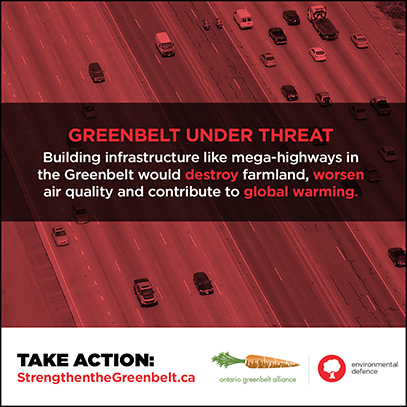Today, the Ontario Greenbelt Alliance and Environmental Defence jointly released a new study, Ontario’s Greenbelt at Risk, which outlines four key threats to the Greenbelt.
Ontario’s Greenbelt protects farmland and natural areas like forests and wetlands from urban sprawl. It ensures that nature isn’t a long drive away, and protects the sources of drinking water for millions of GTA residents. And it ensures that we in the Greater Golden Horseshoe have access to fresh, local food.
But, our world renowned Greenbelt is at risk. Today, the Ontario Greenbelt Alliance and Environmental Defence jointly released a new study, Ontario’s Greenbelt at Risk, which outlines four key threats to the Greenbelt:
- Proposals for infrastructure, such as new mega-highways that would pave over prime farmland, contribute to poorer air quality, and generate more greenhouse gases;
- Sprawl developments in the Greenbelt that would destroy farmland, forest and wetlands and the animals that live there;
- An unnecessary airport in the Greenbelt that would eliminate 7,530 hectares of prime farmland and forests, isolate Rouge Park from the Oak Ridges Moraine, spark development along the boundary of the Rouge Park and contribute to climate change;
- Dumping contaminated soil, which puts water and food sources at risk
The good news is that actions can be taken to reduce each of these threats.
Every 10 years the provincial plans — the Greenbelt Plan, the Oak Ridges Moraine Conservation Plan and the Niagara Escarpment Plan — are reviewed by the province to ensure they’re effective at protecting agricultural lands and nature while maintaining clean water resources and stopping inappropriate sprawl development. And the next review is right around the corner in 2015.
The Greenbelt has been effective at limiting sprawl to protect our farmland and natural spaces, but loopholes in the Greenbelt plan are putting the Greenbelt at risk. The 2015 review is a chance to address these loopholes and strengthen the Greenbelt Plan.
For example, policies currently allow infrastructure like new highways on Greenbelt lands — lands which are supposed to be permanently protected. And, there are plans for at least two mega-highways, the GTA West and Mid-Peninsula, both of which would cut a swath through the Greenbelt. These proposed highways would cost taxpayers $16 billion ($4 billion for the GTA West), destroy thousands of hectares of prime farmland, wildlife habitat, facilitate sprawl and damage water resources.
Instead of paving farmland to build mega-highways that would cause more traffic jams and increase greenhouse gas emissions, the province should invest that same $16 billion in regional rapid transit. That would get more people to their homes and jobs. And it would get people out of their cars, which improves quality of life and reduces congestion, climate change and smog. Not only would strengthening the policies remove the threats to the Greenbelt, it would be consistent with permanently protecting productive farmland and nature.
By identifying these threats, we’re providing the province with an opportunity to strengthen the plans, to make them better, for Ontarians today and for future generations. The 2015 review is the time to build a better Greenbelt, where the policy gaps, problems with plan implementation, and broad issues that impact the protected area can be addressed.
You can help! Take action to strengthen the Greenbelt and stop Greenbelt lands from being paved over and contaminated. Make your voice heard today.
As the 2015 review gets under way, we’ll be sure to let you know other ways to make your voice heard and stand up for Ontario’s Greenbelt. Stay tuned!



